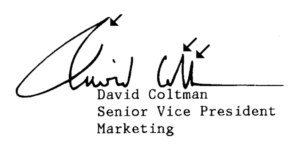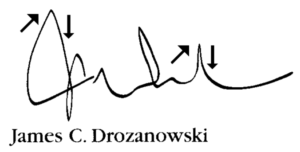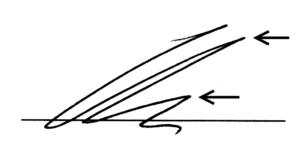Demeaning others
Július Zemaník, Slovak Republic & Dr. Erika Karohs, USA.
Copyright © 2017
This trait stems from strong feelings of inferiority and worthlessness. Because the writer feels inadequate in comparison to others, it evokes fear and uncertainty within. In order to counteract the effect of this fear, the writer employs a defensive strategy of demeaning other. That way he protects himself from loss of self-esteem.
Definition: Demeaning, downgrading of other people (often weaker ones or those who cannot defend themselves) with the intent to put them to a lower level in order to increase one’s self-esteem and self confidence and alleviate inferiority feelings.
Graphic indicator: An acute angle consisting of an upward rightward diagonal stroke that sharply turns downward into a straight stroke.
Possible locations of the stroke:
The acute angle can occur in initial positions, final positions or can be located mid-word as part of the letter structures themselves.
Psychological effect of the stroke and its meaning:
The writer is a deeply fearful person. He can’t stand the thought that someone else could be better (or more talented, intelligent, likeable, popular, successful or happier) than he, himself, is. This would be a major blow to his ego and self-esteem. Even the thought triggers strong feelings of inadequacy and inferiority that then prey on his mind and cause distress.
Those who are allegedly better than him pose a threat to his self-esteem because he needs to feel that he is best in everything he does. If he is not, he feels worthless and may be thrown into a state of depression, anger and/or frustration. He has a constant fear that others could surpass him and that his position is threatened. He is afraid that if they did surpass him, he would suddenly become insignificant and unimpor-tant. In order to alleviate these unpleasant feelings, he vents his inferiority feeling on those who are associated with them or at defenseless substitutes. This is especially true when the writer if frustrated, upset, feels insecure or fears losing face.
He demeans them and tries by all means to put them down to a lower level, preferably below his own so he could shine in comparison to them. That way he can feel better about himself and at the same time camouflage his insecurities. Basically, his goal is to undermine their confidence so they would not be able to feel better than he does or be better off than he is. By demeaning others he fights his own feelings of worthlessness. But in reality, he condemns in others what he most fiercely hates in himself.
Failure of others, their unsuccessfulness or when things don’t go well for them, they all reassure the writer and calm down his inferiority feelings. He does not have to feel so miserable about himself when he sees others failing. In addition, he could then look down upon them and belittle them. His fragile self-esteem gets reinforced, but unfortunately at the expense of others.

The writer’s inner fears and uncertainty make it almost impossible for him to be able to praise other people and their accomplishments. Praising another person means for the writer admitting that someone else could be better than him. Such a thought fills him up with insecurity and fear which he simply cannot bear. He feels that praising others would make him appear weak and vulnerable. Instead, he takes pleasure in pointing out flaws to prove their alleged inferiority (in order to fight his own).
Dr. Erika M. Karohs describes the writer as someone who is inwardly deeply fearful and has a less than adequate self-concept. It is a person who seeks to counterbalance feelings of worthlessness by fault-finding with others so that he can raise himself abo-ve those who are “less perfect.” It’s a game the writer plays against other people to hide his own insecurities, to be able to look better and shine in comparison to them. Nonetheless, because the writer in reality condemns in others what he dislikes most in himself, he is in effect saying: “I don’t like myself for being imperfect, so I can’t let you get away with it.”[2]
With the angle tilted:
The fact that the angle is tilted increases the intensity of this trait.
The writer is especially persistent and merciless in his condemnation of others. He is constantly on the lookout for mistakes or flaws others make, even minute ones. He is just waiting for the opportunity to belittle them. Moreover, the manner in which he puts other down is freezing cold and distant.
The writer depicts others’ accomplishments as insignificant. Basically, he fiercely downgrades their achievements so that he could elevate his own. In order to fight off his strong insecurity feeling, he makes them feel inferior in his presence. This is achieved by constantly reminding them how much better he is, more successful he is, more experienced he is, more awesome he is etc. He makes them feel that they have achieved nothing that worthwhile and are insignificant in comparison to him. In effect the writer is basically saying: “Who do you think you are in comparison to me?”
Needless to say, there are serious flaws in these kinds of assumptions that unnecessarily hurt other people. But that is what the writer is after – to make them feel inferior and undermine their self-confidence and self-esteem so that he could feel temporarily secure and superior to them.
Being superior is of utmost importance to the writer. He will, therefore, not allow anyone in his vicinity to have a chance to surpass him or threaten his position. This is achieved by constantly raising the standards on them.
Putting others down to a lower level is a way for the writer to dominate and control those around him. He insists that they play by his rules and then makes sure they don’t have any chance to become better than him.
He “threads others down” by his demeaning attitude and condemnation so that he, himself, can make progress without the possibility of others standing in his way or posing a threat of any kind to him, and his self-esteem.
If the writer is in a position where he is blamed or demeaned for something (or gains such a feeling and his ego feels threatened), he is quick to find a pretext or reason for which to demean the other person. This is a defensive reaction of the writer to direct the unpleasant feelings evoked by the demeaning away from himself.
Effect of the trait on other people:
Because the writer’s basic aim is to make others feel inferior and to undermine their self-esteem and confidence so he could feel better about himself, their feelings are bound to get hurt. Other people start feeling very uncomfortable in the writer’s presence. The effect of his behavior is that they are all the more eager to get away from him. His demeaning attitude antagonizes most people around him.
Moreover, others may be also saddened when their intentions are genuine but the writer nonetheless behaves in a manner that makes them look worthless or inferior.
For instance, when someone is sincerely happy or excited about something (e.g. wants to share an achievement, ideas, etc.), the writer is likely to turn that person down in a cool manner saying he/she shouldn’t be so excited/happy in case something goes wrong allegedly so the person wouldn’t be disappointed or something to that effect.
The truth behind the writer’s behavior is, however, the fact that he cannot stand seeing other people happy or genuinely excited. Out of spite, he makes them feel miserable in order to feel better about himself.
- The effect of the trait on persons in positions of authority:
This trait can cause serious problems in the relationships between superiors and subordinates. The main reason is that a superior possessing the trait of demeaning others is apt to take delight in putting down his subordinates to a lower level. Due to his own inferiority feelings, he is likely to dismiss the efforts of others and look for ways to make others look incompetent so he could shine in comparison to them (and feel good about himself). His main goal is not to work together towards achievement but rather to use others to increase his self-worth.
Should one of his employees make a mistake, he is likely to severely reprehend the person with negative or even demeaning comments on his performance. On the other hand, if they do well, the boss is likely to dismiss it as insignificant in comparison to his efforts and to what he allegedly has to do for the company.
Such an attitude, however, can have a devastating effect on productivity. After some time, the employees may gain the feeling that they are not appreciated for what they do and gain the feeling “why even bother.” Their frustration is likely to grow every time they try hard and get dismissed or every time they make a mistake (even a small blunder or nuance) and are harshly reprimanded.
When others are doing well, the writer may gain the feeling that his position is threatened and his defensive attitude is all the more likely to become activated. If that is the case, the writer is not above “threading others down”. Being superior is very important to him, and, in order to secure superiority and his superior position, he is likely to demand more and more of his employees (even if it is not realistic) so he could have some kind of pretext for demeaning them. His goal is to make it impossible for others to even have the possibility of surpassing him. The standard is being constantly raised on them.
- The effect of the trait on persons in subordinate positions:
The writer is basically a very insecure person. If he got, as an employee, for example rebuked, his feelings of self-worth would be drastically shaken. Feeling of inferiority would creep up and the writer would feel the need to reinforce his self-esteem.
But because it could be potentially dangerous to discharge these feelings on his superior, frustration builds up within and the writer is forced to look for a substitute, a target at which to vent his inferiority feelings.
He needs to take his inferiority and hostility out on someone and usually chooses those who comparatively equal to him or are preferably weaker such as those under his command. Regarding the writer’s safety, they are relatively “safe” to demean.
This can lead to him demeaning his subordinates or colleagues in order to be able to elevate himself above them and prove his superiority over them.
As a result, the writer may have seriously strained relationships, because other people dislike being in his company for too long for this very reason.
Final remarks:
The acute angle of demeaning others was described by a German graphologist Magdalena Ivanovic in her book “Die Gesetze der modernen Graphologie” (Laws of modern graphology).
According to Ivanovic, acute angles as a rule illustrate personality traits that are of a malevolent, spiteful nature. They partly represent character deficiencies and partly human failings[3]. The acute angles expose a more covert, hidden kind of hostility.[4]
Magdalena Ivanovic had an exceptional ability to interpret unusual graphic indicators. She was able to describe a multitude of stroke formations that are still little known to most graphologists today. This is not because they appear only scarcely in handwritings. Quite the contrary! But it takes a trained eye to be able to notice them and one has to know the individual configurations and specific shapes of the strokes as well as the direction of their movement. Moreover, little is written about them, even in serious graphological literature.
Amongst her most significant discoveries belong single, double, expanded curves, various angles, straight and diagonal strokes and the discovery of the air stroke (she called it the “immaterial” stroke).
These indicators are so meaningful because they are mostly unconscious additions (in case of curves, strokes and angles) to the letters and generally remain inconspicuous in the overall writing picture. But their informative value is manifold and extensive. Much additional insight can be gleaned from them for a much more thorough analysis.
The kinds of information provided in this paper are based upon Erika M. Karohs’ book “Personality Traits At a Glance” with additional information and illustrations provided by the author of this paper. It has been written with the intent to fill a gap in the area of these infrequently mentioned indicators.
[1] These two illustrations are from Dr. Erika M. Karohs’ book Personality Traits At A Glance, Traits In Handwriting You Should Know – But Probably Don’t (Pebble Beach, CA: Self-published, 2001), p. 98, and have been included with the written permission from the author
[2] Erika M. Karohs, Personality Traits At A Glance, Traits In Handwriting You Should Know – But Probably Don’t (Pebble Beach, CA: Self-published, 2001), p. 98
[3] Magdalena Ivanovic, Die Gesetze der modernen Graphologie (Prien, Obb: Anthropos Verlag, no date), p. 76
[4] Erika M. Karohs, Personality Traits At A Glance, Traits In Handwriting You Should Know – But Probably Don’t (Pebble Beach, CA: Self-published, 2001), p. 88
About the Author:
Demeaning Others
Július Zemaník is the youngest graduate to have finished our courses with highest honors. Aside from the course studies, Július has privately studied other great graphologists in history, especially the life and works of the late Magdalena Ivanovic, one of the foremost European graphologists. Aside from Dr. Karohs, Julius is probably the most knowledgeable expert about Ivanovic.
Personality Traits at a Glance
This is a one-of-a-kind book. Personality Traits At a Glance lists traits not found in conventional basic handwriting analysis courses. They were discovered by Magdalene Ivanovic, a renowned German graphologist. Using the information from this book, analysts can glean immediate insight into significant aspects of a writer’s personality from simply identifying individual strokes, curves, or angles. The book is especially helpful when (a) nothing but the signature is available; (b) the handwriting sample is very small; (c) the handwriting is mostly illegible. Analysts who have bought this book tell me that they are using it almost daily in their analysis work.
Info : 1 Volume; 130 Pages Price : $ 32
HOME
Click here to back to KAROHS Home Page
COURSE
Click here to see our Course Programs
BOOKS
Click here to see our Books Store
Copyright © 2018 the KAROHS International School of Handwriting Analysis®. All rights reserved.
No image or portion of this website may be copied or reproduced without written permission.








